A study on the effects of three different intensity of plyometric training on football players
Main Article Content
Authors
Abstract
Football players need to be physically fit so that they can run with strength, change directionquickly off the mark to control the game, pass properly, and tackle effectively for the duration of the game.In addition, players need to be able to tackle well for the duration of the game. In addition to having theskills required to play the game, individuals who are interested in playing football need to be inexceptional physical condition in order to participate. Plyometric exercises, as their name suggests, aremeant to aid a muscle in reaching its maximal strength in the quickest length of time possible. Plyometricexercises are often performed in a jumping motion. There is a large variety of different types of physicalactivities that may be done in addition to jumping, which is the primary focus of the vast majority of theexercises in this category. The phrase measurable growth derives from a combination of two Latinwords increase and measure. Both the English term measure and the Latin word increase havetheir origins in the Latin language.
Downloads
Download data is not yet available.
Article Details
Section
Articles
References
- Barrow, Harold, M., and Rosemary McGee, (1979) “A practical approach to measurement in Physical Education”, Philadelphia, Lea and Febiger.
- Fleck, S., and W.Kraemer, Designing Resitance training Programs, Champaign, II: Human Kinetics. 1987.
- Cavagna, G.A., Storage and utilization of elastic energy in skeletal muscle. In: Exercise and Sport science Reviews, vol 5, R.S. Jutton, ed. Santa Barbara, CA: Journal Afiliates. 1977. pp. 80-129.
- Herman, D. (1976). The effects of depth jumping on verticial jumping and sprinting speed. Unpublished master’s thesis, Ithaca College, Ithaca, NY.
- Asmussen, E, and F. Bonde- Peterson Storage of elastic energy in skeletal muscles in man, Acta Physio, Scand, 91:385-392. 1974.
- Impellizzeri FM, Maffiuletti NA. (2007)Convergent evidence for construct validity of a 7-point likert scale of lower limb muscle soreness.Clin J Sport Med.17(6):494-6.
- Diallo O, Dore E, Duche P, Van Praagh E.(2001)Effects of plyometric training followed by a reduced training programme on physical performance in prepubescent soccer players. J Sports Med Phys Fitness. 2001 Sep;41(3):342-8.
- Gambetta, V. (1988), Plyometric training: Understanding and coaching power development for sport (Videotape) Lincoln, NEL National Strength and Conditioning Association.
- Matavulj, D., kukolj ,M.,Ugarkovic ,J.,Tihanyi,J. and Jaric ,S.(2001)effects of plyometrics training on jumping performance in junior basketball players. Journal of sports medicine and physical fitness 41,159-164
- Dursenev, L.and L.Raeysky. Strength training for jumpers, Soviet Sports Rev. 14(2): 53- 55. 1979.
- Aura, O., and J.T. Vitasalo, Biomechanical Characteristics of jumping, Int.J. Sport Biomech. 5(1): 89-97, 1989.
- Herrero JA, Izquierdo M, Maffiuletti NA, García-López J.(2006) Electromyostimulation and plyometric training effects on jumping and sprint time. Int J Sports Med.27(7):533-9.
- Pietraszewski B, Rutkowska-Kucharska A.(2011) Relative power of the lower limbs in drop jump. Acta Bioeng Biomech. 13(1):13-8.

